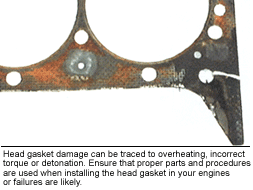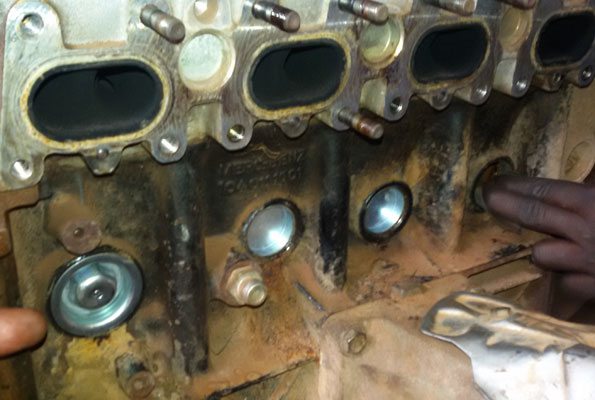Coolant leaks can occur anywhere in the cooling system. Nine out of ten times, coolant leaks are easy to find because the coolant can be seen dripping, spraying, seeping or bubbling from the leaky component. The first symptom of trouble is usually engine overheating. But your car may also have a Low Coolant indicator lamp. If you suspect your vehicle has a coolant leak, open the hood and visually inspect the engine and cooling system for any sign of liquid leaking from the engine, radiator or hoses.
The color of the coolant may be green, orange or yellow depending on the type of antifreeze in the system. You may also notice a sweet smell, which is a characteristic odor of ethylene glycol antifreeze.
The most common places where coolant may be leaking are:
 A worn seal on the water pump shaft can leak coolant.
A worn seal on the water pump shaft can leak coolant.
Water pump — A bad shaft seal will allow coolant to dribble out of the vent hole just under the water pump pulley shaft. If the water pump is a two-piece unit with a backing plate, the gasket between the housing and back cover may be leaking. The gasket or o-ring that seals the pump to the engine front cover on cover-mounted water pumps can also leak coolant. Look for stains, discoloration or liquid coolant on the outside of the water pump or engine.
 This radiator is badly corroded and is not worth fixing
This radiator is badly corroded and is not worth fixing
Radiator — Radiators can develop leaks around upper or loser hose connections as a result of vibration. The seams where the core is mated to the end tanks is another place where leaks frequently develop, especially on aluminum radiators with plastic end tanks. On copper/brass radiators, leaks typically occur where the cooling tubes in the core are connected or soldered to the core headers. The core itself is also vulnerable to stone damage. Internal corrosion caused by old coolant that has never been changed can also eat through the metal in the radiator, causing it to leak.
Most cooling systems today are designed to operate at 8 to 14 psi. If the radiator can’t hold pressure, your engine will overheat and lose coolant.
 Pinch hoses to check for age cracks, hardening, soft spots, blisters or bulges.
Pinch hoses to check for age cracks, hardening, soft spots, blisters or bulges.
Hoses — Cracks, pinholes or splits in a radiator hose or heater hose will leak coolant. A hose leak will usually send a stream of hot coolant spraying out of the hose. A corroded hose connection or a loose or damaged hose clamp may also allow coolant to leak from the end of a hose. Sometimes the leak may only occur once the hose gets hot and the pinhole or crack opens up.
Freeze plugs — These are the casting plugs or expansion plugs in the sides of the engine block and/or cylinder head. The flat steel plugs corroded from the inside out, and may develop leaks that are hard to see because of the plug’s location behind the exhaust manifold, engine mount or other engine accessories. On V6 and V8 blocks, the plugs are most easily inspected from underneath the vehicle.
Heater Core — The heater core is located inside the heating ventilation and air conditioning (HVAC) unit under the dash. It is out of sight so you cannot see a leak directly. But if the heater core is leaking (or a hose connection to the heater core is leaking), coolant will be seeping out of the bottom of the HVAC unit and dripping on the floor inside the passenger compartment. Look for stains or wet spots on the bottom of the plastic HVAC case, or on the passenger side floor. Some Chrysler vehicles have a reputation for developing coolant leaks in the heater core, and repeat heater core failures. Some have found that an aftermarket copper/brass replacement heater core lasts longer in these applications than the original equipment aluminum heater core.
Intake Manifold gasket — The gasket that seals the intake manifold to the cylinder heads may leak and allow coolant to enter the intake port, crankcase or dribble down the outside of the engine. Some engines such as General Motors 3.1L and 3.4L V6 engines as well as 4.3L, 5.0L and 5.7L V8s are notorious for leaky intake manifold gaskets. The intake manifold gaskets on these engines are plastic and often fail at 50,000 to 80,000 miles. Other troublesome applications include the intake manifold gaskets on Buick 3800 V6 and Ford 4.0L V6 engines.
INTERNAL COOLANT LEAKS
There are the worst kind of coolant leaks for two reasons. One is that they are impossible to see because they are hidden inside the engine. The other is that internal coolant leaks can be very expensive to repair.

Bad head gasket –Internal coolant leaks are most often due to a bad head gasket. The head gasket may leak coolant into a cylinder, or into the crankcase. Coolant leaks into the crankcase dilute the oil and can damage the bearings in your engine. A head gasket leaking coolant into a cylinder can foul the spark plug, and create a lot of white smoke in the exhaust. Adding sealer to the cooling system may plug the leak if it is not too bad, but eventually the head gasket will have to be replaced.
If you suspect a head gasket leak, have the cooling system pressure tested. If it fails to hold pressure, there is an internal leak. A “block tester” can also be used to diagnose a leaky head gasket. This device draws air from the cooling system into a chamber that contains a special blue colored leak detection liquid. Combustion gases will react with the liquid and cause it to change color from blue to green if the head gasket is leaking.
Head gasket failures are often the result of engine overheating (which may have occurred because of a coolant leak elsewhere in the cooling system, a bad thermostat, or an electric cooling fan not working). When the engine overheats, thermal expansion can crush and damage portions of the head gasket. This damaged areas may then start to leak combustion pressure and/or coolant.
 A cracked cylinder head can leak coolant inside the engine.
A cracked cylinder head can leak coolant inside the engine.
Cracked Head or Block — Internal coolant leaks can also occur if the cylinder head or engine block has a crack in a cooling jacket. A combustion chamber leak in the cylinder head or block will leak coolant into the cylinder. This dilutes the oil on the cylinder walls and can damage the piston and rings. If the coolant contains silicates (conventional green antifreeze), it can also foul the oxygen sensor and catalytic converter. If enough coolant leaks into the cylinder (as when the engine is sitting overnight), it may even hydro-lock the engine and prevent it from cranking when you try to start it. Internal leaks such as these can be diagnosed by pressure testing the cooling system or using a block checker.
A coolant leak into the crankcase is also bad news because it can damage the bearings. Coolant leaking into the crankcase will make the oil level on the dipstick appear to be higher than normal. The oil may also appear frothy, muddy or discolored because of the coolant contamination.
Leaky ATF oil cooler — Internal coolant leakage can also occur in the automatic transmission fluid oil cooler inside the radiator. On most vehicles with automatic transmissions, ATF is routed through an oil cooler inside the radiator. If the tubing leaks, coolant can enter the transmission lines, contaminate the fluid and ruin the transmission. Red or brown drops of oil in the coolant would be a symptom of such a leak. Because the oil cooler is inside the radiator, the radiator must be replaced to eliminate the problem. The transmission fluid should also be changed.
PRESSURE TESTING THE COOLING SYSTEM FOR LEAKS
There are several ways to find out whether or not your cooling system is holding pressure. One is to top off your cooling system, tighten the radiator cap and start the engine. When the engine reaches normal operating temperature, turn on the air conditioner (to increase the cooling load on the system) and/or take it for a short drive. Then check the radiator, hoses and water pump for seepage or leaks.
WARNING: DO NOT open the radiator cap while the engine is hot! Even if the cooling system is leaking, the coolant will be under considerable pressure — especially if it is low and coolant is boiling inside the engine. Shut the engine off and let it sit about an hour so it can cool down. Then place a rag over the radiator cap and slowly turn the cap until it starts to release pressure. Wait until all the pressure has vented before turning the cap the rest of the way off.
 Radiator pressure test kit
Radiator pressure test kit
A special tool called a pressure tester can also be used to check your cooling system. The tool is nothing more than a little hand pump with a combination vacuum-pressure gauge and a fitting that is attached to the radiator filler neck. To check for leaks, attach the tool to the radiator and pressurize the radiator to the pressure rating on the radiator cap. For example, if you have a radiator cap that says 12 pounds, you pressurize the radiator to 12 lbs. and wait to see what happens. If there are no leaks, the system should hold pressure for 10 to 15 minutes. If it does not hold pressure, the system is leaking. If you cannot see any visible leaks on the outside, it means the leak is inside (bad head gasket or cracked head or block). See How to Fix a Leaky Head Gasket.
A block Checker is another tool that can be used to detect a leaky head gasket. The gas-sensitive blue liquid changes color if there are any combustion gases in the coolant.
Leak detection dye can also be added to the coolant itself to make a slow leak easier to find. Some of these dyes glow bright green or yellow when exposed to ultraviolet light.
RADIATOR CAP CHECKS
The radiator cap should also be pressure tested, especially if the system has been overheating or losing coolant with no obvious external leaks. A weak cap that cannot hold pressure will allow the system to boil over. If the cap cannot hold its rated pressure, replace it.
 The best fox for a leaky radiator is to replace it with a new or recored radiator.
The best fox for a leaky radiator is to replace it with a new or recored radiator.
REPAIRING A LEAKY RADIATOR
If your radiator is leaking, you have several repair options:
You can try the cheap fix and add a bottle of cooling system sealer to the radiator. These products are designed to seal small leaks. They can also seal internal engine leaks. Some work better than others, but most provide only a temporary solution to your problem.
You can attempt to repair the radiator yourself. Copper/brass radiators on older vehicles can often be soldered to repair leaks. Cracks or pinholes in aluminum radiators in newer vehicles can often be repaired with epoxy glue. But if the core is severely corroded or damaged, the radiator may have to be professionally repaired at a radiator shop, or replaced with a new radiator.

